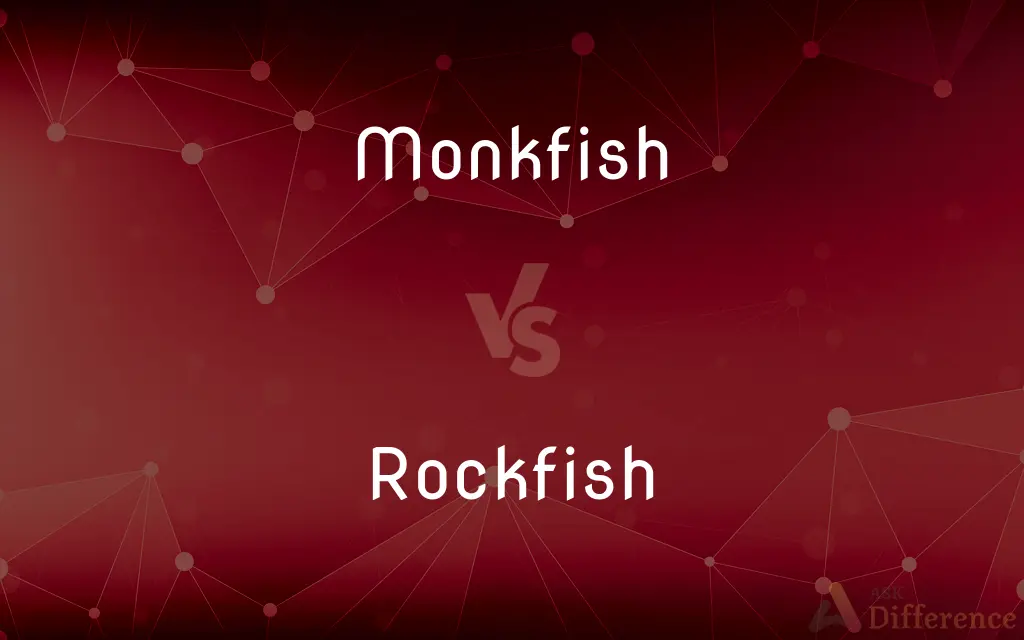Monkfish vs. Rockfish — What's the Difference?
By Tayyaba Rehman & Maham Liaqat — Updated on April 25, 2024
Monkfish and rockfish are both sea creatures, but monkfish, known for its meaty texture, is often compared to lobster, whereas rockfish, diverse in species, is praised for its mild flavor.

Difference Between Monkfish and Rockfish
Table of Contents
ADVERTISEMENT
Key Differences
Monkfish, a bottom-dwelling fish found in the Atlantic Ocean, is renowned for its firm, meaty texture that closely resembles that of lobster, making it a popular choice for various culinary preparations. Its flavor is subtle yet distinctive, often described as sweet and similar to shellfish, which has earned it the nickname "poor man's lobster." On the other hand, rockfish refers to a large family of fish known as Sebastes, found in the Pacific Ocean. Rockfishes vary greatly in color, size, and habitat, leading to a wide range of textures and flavors among the species. Generally, rockfish has a milder taste compared to monkfish, with a flaky texture that makes it suitable for a variety of cooking methods such as baking, frying, and stewing.
While monkfish primarily thrives in the cold waters of the Atlantic, making it more common in European and North American cuisines, rockfish are predominantly found in the Pacific, playing a significant role in Asian and North American Pacific coastal cuisines. This geographic difference not only influences the availability of these fishes but also their culinary uses and cultural significance.
Monkfish's unique appearance, featuring a large head and mouth, has contributed to its lesser appeal at fish markets, despite its delicious taste. Conversely, rockfish, with its more conventional appearance, is often sold whole or filleted, making it more visually appealing to consumers.
The sustainability concerns surrounding both species are significant but differ in nature. Monkfish, once overfished, has seen successful conservation efforts in some regions, yet still faces challenges. Rockfish populations have also been overexploited, leading to strict regulations to promote their recovery, especially in the U.S. where certain species were listed as endangered but have shown signs of recovery thanks to management efforts.
Comparison Chart
Habitat
Atlantic Ocean
Pacific Ocean
ADVERTISEMENT
Texture
Firm, meaty
Mild, flaky
Flavor
Sweet, similar to lobster
Mild, varies among species
Culinary Uses
Grilling, roasting, poaching
Baking, frying, stewing
Conservation
Managed but faces challenges
Recovering, with strict regulations
Compare with Definitions
Monkfish
Firm Texture.
The firm texture of monkfish makes it ideal for grilling.
Rockfish
Mild Flavor.
Rockfish is known for its mild and versatile flavor.
Monkfish
Conservation Challenges.
Conservation efforts for monkfish have faced significant challenges.
Rockfish
Flaky Texture.
The flaky texture of rockfish makes it perfect for baking.
Monkfish
Sweet Flavor.
Monkfish is often described as having a sweet flavor reminiscent of lobster.
Rockfish
Diverse Species.
The rockfish family includes a wide range of species with various flavors and textures.
Monkfish
Atlantic Habitat.
Monkfish are commonly found in the cold waters of the Atlantic Ocean.
Rockfish
Pacific Habitat.
Rockfish species are primarily found in the Pacific Ocean.
Monkfish
Versatile in Cooking.
The versatility of monkfish allows for a variety of cooking methods.
Rockfish
Recovery Efforts.
Recovery efforts for rockfish have been successful in some regions.
Monkfish
See goosefish.
Rockfish
Any of various fishes living among rocks.
Monkfish
Any large bottom-dwelling anglerfish of the genus Lophius, such as Lophius piscatorius, of the Atlantic, having a large head and mouth.
Rockfish
Any of various food and game fishes chiefly of the genus Sebastes of the North Pacific, having mildly venomous spines in their dorsal fins. Also called rock cod.
Monkfish
Angel sharks of the genus Squatina.
Rockfish
See striped bass.
Monkfish
The angel fish (Squatina).
Rockfish
Any of a large number of different species of fish, which dwell among rocks, specifically:
Monkfish
Flesh of a large-headed anglerfish of the Atlantic waters of North America
Rockfish
A fish in the family Sebastidae, marine fishes that inhabit oceans around the world
Monkfish
Fishes having large mouths with a wormlike filament attached for luring prey
Rockfish
Acanthoclinus, a genus of fish from New Zealand
Monkfish
Sharks with broad flat bodies and winglike pectoral fins but that swim the way sharks do
Rockfish
Scyliorhinus stellaris (nursehound), a shark known as rock salmon when used in cuisine
Rockfish
Hexagrammos, a genus of greenling from the North Pacific
Rockfish
Hypoplectrodes, a genus of fish in the family Serranidae
Rockfish
Salvelinus, a genus of fish in the salmon family
Rockfish
A stonefishes (genus Synanceia), venomous fishes from the Indo-Pacific
Rockfish
A striped bass (Morone saxatilis), a species of fish from North America
Rockfish
Certain groupers, in the subfamily Epinephelinae
Rockfish
Certain fish of genus Scorpaena, such as Madeira rockfish (Scorpaena maderensis), a common Mediterranean species
Rockfish
Myliobatis goodei (southern eagle ray)
Rockfish
A logperch (Percina caprodes), also known as common logperch or log perch
Rockfish
A long-spined bullhead (Taurulus bubalis)
Rockfish
A black person who does not know how to swim.
Rockfish
Any one of several California scorpænoid food fishes of the genus Sebastichthys, as the red rockfish (Sebastichthys ruber). They are among the most important of California market fishes. Called also rock cod, and garrupa.
Rockfish
The lean flesh of any of various valuable market fish caught among rocks
Rockfish
Marine food fish found among rocks along the northern coasts of Europe and America
Rockfish
Marine food and game fish with dark longitudinal stripes; migrates upriver to spawn; sometimes placed in the genus Morone
Common Curiosities
Are rockfish and red snapper the same?
No, rockfish and red snapper are different species, though they are sometimes confused due to similar textures and flavors.
How do you cook rockfish?
Rockfish can be cooked in various ways, including baking, frying, and stewing.
Are there sustainability concerns for monkfish?
Yes, there are sustainability concerns, although conservation efforts have been made.
Why is monkfish called "poor man's lobster"?
Because of its similar taste and texture to lobster, yet historically it was less expensive.
What makes monkfish similar to lobster?
Monkfish is similar to lobster due to its firm, meaty texture and sweet flavor.
Is monkfish more expensive than rockfish?
Monkfish can be more expensive than some types of rockfish, depending on availability and demand.
What are the main culinary uses of monkfish?
Monkfish is versatile, ideal for grilling, roasting, and poaching.
Can you eat the whole monkfish?
The tail meat is the most commonly eaten part of the monkfish.
Can rockfish be eaten raw?
Yes, some species of rockfish are suitable for sushi or sashimi.
Which is healthier, monkfish or rockfish?
Both are healthy options, offering good sources of protein and omega-3 fatty acids.
Is rockfish good for frying?
Yes, its mild flavor and flaky texture make it suitable for frying.
What are the main differences between monkfish and rockfish?
The main differences lie in their habitat, texture, flavor, and culinary uses.
How many species of rockfish are there?
There are over 100 species of rockfish, each with unique characteristics.
How do you identify a monkfish?
Monkfish can be identified by its large head and mouth.
What is the main habitat of monkfish?
Monkfish are primarily found in the Atlantic Ocean.
Share Your Discovery

Previous Comparison
Lucifer vs. Venus
Next Comparison
Rocket vs. SatelliteAuthor Spotlight
Written by
Tayyaba RehmanTayyaba Rehman is a distinguished writer, currently serving as a primary contributor to askdifference.com. As a researcher in semantics and etymology, Tayyaba's passion for the complexity of languages and their distinctions has found a perfect home on the platform. Tayyaba delves into the intricacies of language, distinguishing between commonly confused words and phrases, thereby providing clarity for readers worldwide.
Co-written by
Maham Liaqat















































